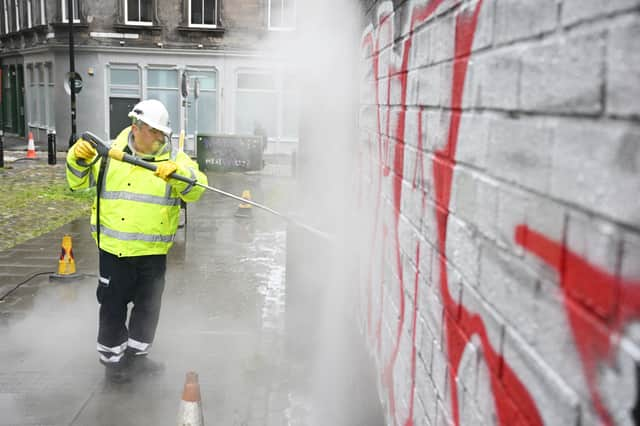Edinburgh's graffiti task force could expand its work to cover private property as well as public buildings


A council graffiti-removal task force in Edinburgh could expand its work to cover private property following a summit on how to tackle the problem.
An extra £750,000 was recently invested by the council to boost clean-up operations across the Capital with specialist vehicles to remove graffiti from public buildings and infrastructure.
Advertisement
Hide AdAdvertisement
Hide AdBut the vast majority of graffiti in the city is on private property and now discussions are to take place about the service being extended, with private property owners paying for the specialist council staff to carry out graffiti removal on their premises.
The graffiti summit, chaired by council leader Cammy Day, brought together police, parliamentarians, business leaders, heritage organisations, residents’ groups and members of the street art community, as well as councillors and the council’s street cleansing team.
Those taking part highlighted the difference between vandalism and street art, and some suggested "tolerance zones" and murals like Colinton Tunnel and Marine Parade could be part of the answer. But there was also concern about the impact of graffiti on historic buildings and structures.
Councillors and officials will now consider options for expanding the council’s graffiti removal service in partnership with Police Scotland, heritage groups and community representatives before reconvening the wider group to discuss next steps.
Advertisement
Hide AdAdvertisement
Hide AdTransport convener Scott Arthur said: "It’s clear from our discussions that we all share the same aim – we want to be proud of the city we live in and for people who come here to love it as much as we do.
"There’s a real spectrum of ‘graffiti’, from formal murals like Colinton Tunnel which have the consent and support of the community, through to offensive tags. I know many of the complaints we receive are about the latter.
"One of the key outcomes was to work with both the private and public sector to solve this problem, whether that’s sharing data with the police to help them to identify the extent of the problem or working with stakeholders to provide an enhanced service.
"This adds to the £750,000 investment we’ve already made this year, which is allowing our excellent cleansing and graffiti teams to use specialist vehicles to focus on removing graffiti from public buildings and infrastructure, as well as power washing areas such as streets, pavements and steps which need it most."
Advertisement
Hide AdAdvertisement
Hide AdLiz McAreavey, chief executive of Edinburgh Chamber of Commerce, stressed the "vast difference" between graffiti as street art and as vandalism. She said: "When street art is approved and in an agreed space it’s an opportunity for young artists and I think harnessing that could potentially be a good way of reducing the incidence of vandalism and recognising young talent.
"It’s very much a ‘Team Edinburgh’ approach. This isn’t something that can be solved overnight but we need outcomes that will support the visitor experience, support the private sector who are having to deal with this and understanding the value that creative street art can bring to the city as well."
Ross Blair, founder and creative director of creative agency TrenchOne Industries, said there needed to be education across the board about what constitutes graffiti. "People use graffiti as a catch-all term that covers vandalism, tags, murals and art on walls, but it’s more nuanced than that."
And he continued: "We’re getting some great talent in the city and I think we should be celebrating that. We should focus on young people, educating them and encouraging them to become artists. It’s about having inclusive discussions, between all council areas, local groups, artists and other stakeholders to understand different points of view."
Advertisement
Hide AdAdvertisement
Hide AdComment Guidelines
National World encourages reader discussion on our stories. User feedback, insights and back-and-forth exchanges add a rich layer of context to reporting. Please review our Community Guidelines before commenting.